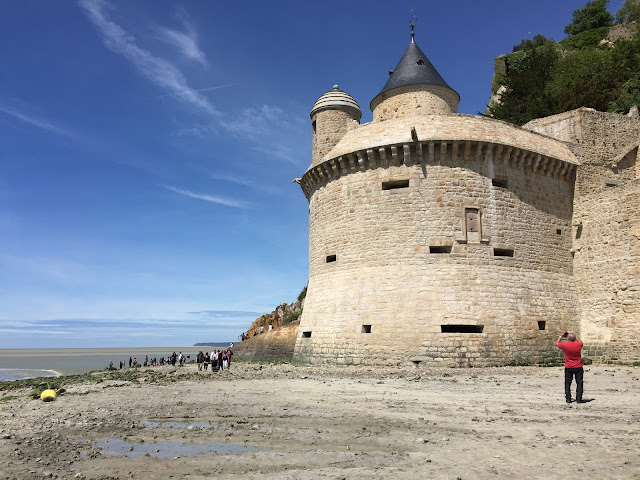Our trip to France this year took us to the northwest part
of France—to Normandy. I’ve been wanting to visit this historical region for
several years; it played a huge part during World War II. To quote from Wikipedia,
‘the Normandy landings (codenamed Operation Neptune) were the
landing operations on Tuesday, 6 June 1944 (termed D-Day) of the Allied
invasion of Normandy in Operation Overlord during World War II. The largest
seaborne invasion in history, the operation began the liberation of
German-occupied northwestern Europe from Nazi control, and contributed to the
Allied victory on the Western Front’. On June 6, 1944, the Allied
troops (American, British and Canadian) stormed a handful of beaches along the
coast of Normandy in order to fight the Germans and ended up turning the tides
of World War II. But it did not happen without a lot of bloodshed. The Allied
troops landed on five beaches—designated Omaha and Utah (American troops), Juno
(Canadian troops), Gold (British troops) and Sword (Canadian and British
troops). We chose to visit Omaha Beach, which saw the most casualties. From a
distance, the sands look almost reddish-brown, a poignant reminder of the blood shed on
this beach. It runs for a length of 8 kilometers (5 miles); at present, it’s a
public beach, open for all, and lined with several small restaurants and cafes.
There are also some lovely houses along the road that parallels the beach. There
are signs detailing the history of the beach and a couple of memorials. We
walked along it for about two miles, and then stopped for some iced tea at one
of the cafes along the beach.
I found it very moving to stand on Omaha beach, looking out
over the ocean, knowing that many of the American soldiers that landed here
never made it home. They never had the chance to fall in love, marry, raise a
family, have a career—all those things that we take for granted. Think about
that, about how privileged we are, never to have known a major world war in our lifetimes (thus far). Being there made me understand why my father,
who was stationed for three years in England during WWII, never wanted to talk
about the war in any great depth. His job was to load bombs onto planes, which
ruined his back for the rest of his life. I think he was just glad to get home
to America and to move on from that experience. Sometimes he told us stories
about his time in the army, but they mostly had to do with the discipline and
routines that the soldiers had to follow, and were usually to illustrate a
point or to help enforce the rules he and my mother set for us children.
I had a similar emotional reaction when we visited the Normandy
American Cemetery afterward. This cemetery, in Colleville-sur-Mer, is situated
on the cliffs above Omaha Beach and looks down onto the beach itself. It is the
burial site of 9,387 American soldiers, the majority of whom lost their lives
in the D-Day landings and subsequent operations. There are also Walls of the
Missing, on which are inscribed 1,557 names of those who ended up missing or
unidentifiable.
 |
| the reddish-brown sands of Omaha Beach |
 |
| view of Omaha Beach from the American Cemetery |
Our hotel was in Caen, an old and very historic city (of William the Conqueror fame). Our trip to Omaha Beach from Caen took about an hour each way, and our trip to the island of Le Mont Saint Michel took about ninety minutes each way. Caen itself was a lovely small city, easy to drive around in and to get to know. We visited the Memorial de Caen, a memorial and war museum dedicated to peace, and one of, if not the best, war history museums I’ve ever encountered. As my husband said, everyone should visit this museum because you will learn so much about WWII and the economic and social conditions in Europe that led up to it, about the rise of Hitler and the Nazis, the Jewish ghettos, the Russia front, and the Normandy invasions. It is an amazing history lesson and I highly recommend visiting it.
Le Mont Saint Michel, which is on the list of UNESCO’s World Heritage Sites, is a wonder to behold from a distance and up close. The island draws its name from the monastery at the topmost part of the island; below the monastery, there are stores and housing—nowadays those stores are tourist gift shops and restaurants. It is a steep climb to the top of the island, and a climb that one makes together with hundreds of other visitors; about three million people visit the island each year. What makes this place special are the tidal waters that both cut off and connect the island to the mainland. According to Wikipedia,
‘the tides can vary greatly, at roughly 14 metres (46 ft) between high and low water marks’. When the tide goes out, it can go out as far as 25 km, and when it comes back in, it comes rushing back in. So even though there is now a bridge that connects the island to the mainland, it can still be perilous to walk on the beaches surrounding the island because of the tide rushing in and because some of the areas on the beaches are like quicksand. It is recommended that you walk around on the beaches with an experienced guide. The Tour de France bicycle race started here this year, and it couldn’t have been a more beautiful place to start.
 |
| Mont Saint Michel from a distance showing the bridge out to the island |
 |
| seagull modeling for photographers |
 |
| the beaches surrounding the island |
 |
| tide coming back in |
 |
| flags at entrance to the Memorial Museum in Caen |










































